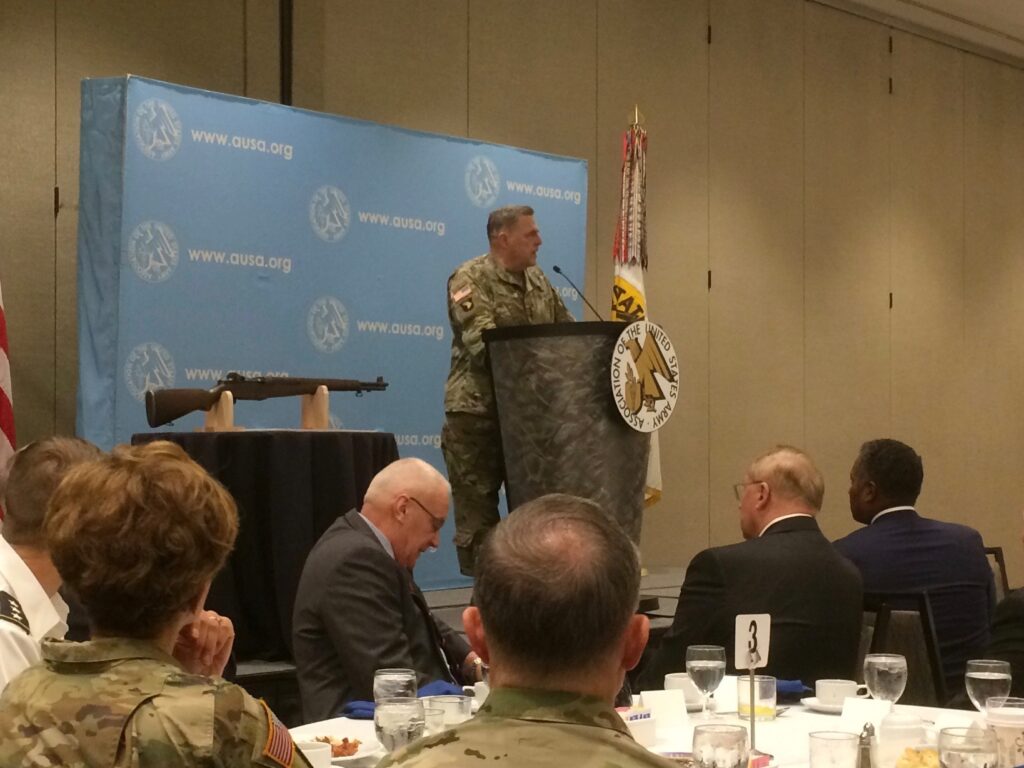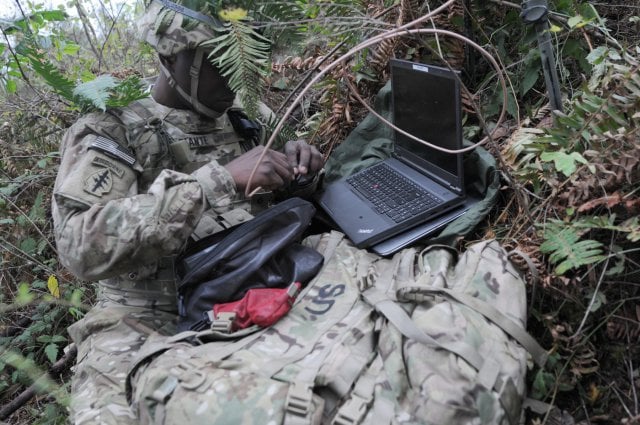
Gen. Mark Milley addresses the Association of the US Army. At left is a restored M1 Garand rifle belonging to a fallen soldier from World War II.
ARLINGTON: The Army needs new weapons to fight for the air, the airwaves and cyberspace against a high-end adversary such as Russia or China, Chief of Staff Gen. Mark Milley said today. While the Army’s near-term readiness to “fight tonight” remains Milley’s top priority, there’s enough progress on readiness — and enough potential for a budget boost under Trump — to spend more time and money on long-term modernization, which determines the Army’s readiness to fight tomorrow.

Multiple Launch Rocket System (MLRS) barrage
So I asked Gen. Milley at an Association of the US Army breakfast this morning to list his modernization priorities, the areas where he’s most concerned about a shortfall. Almost everything he named was meant for a high-intensity, high-tech war against a great-power adversary. That’s no surprise, coming from a general who’s named Russia as the No. 1 threat. It also aligns nicely with prospective Defense Secretary James Mattis, who testified today that “we must field a decisive conventional force,” a priority Mattis put second only to the nuclear deterrent — and ahead of irregular warfare (COIN) against guerrillas and terrorists. Milley’s priorities are clearly about conventional war.
- Air defense was the first shortfall Milley listed. The Army is used to Air Force, Navy, and Marine Corps pilots securing the airspace overhead — no American soldier has died from air attack since the Korean War — but advanced anti-aircraft missiles might keep American aircraft at bay. That means Army units must rebuild the capability to defend themselves from enemy aircraft, particularly low-flying drones, which have become so common even Daesh (Islamic State) has successfully used them to kill.
- A high-end adversary will possess its own air defenses, which means Army helicopters need better protection to survive. “Aviation is very vulnerable against a near-peer, high-end threat,” Milley said. “It’s one thing to fight guerrillas and terrorists where you have almost exclusive freedom of the air.” Milley mentioned not only defensive systems but upgraded engines — presumably the Improved Turbine Engine Program, or ITEP — to improve helicopter performance.
- A high-end adversary will also have artillery, a particular specialty of the Russians and the Chinese 2nd Artillery rocket force. Milley said the service was investing both in “non-traditional” weapons like lasers — whose chief value is defensive, shooting down incoming drones, shells, and rockets — and in extended-range munitions for conventional artillery, both cannon and missile.
- One priority relevant to both conventional and irregular warfare is ground vehicles. “Ground mobility is a big deal,” Milley said, “especially with our light force.” The Army is developing an air-droppable off-road truck to transport foot troops over long distances, the Ground Mobility Vehicle, as well as an air-deployable light tank, the Mobile Protected Firepower vehicle. The added firepower and mobility still wouldn’t let a light infantry brigade go head-to-head with Russian tank divisions, but it would be valuable on the flanks of a mechanized battle or against a lightly armed foe such as the Islamic State.
- Milley’s most complex priority: cyber and electronic warfare, the battle to keep our own command-and-control networks up and running while bringing the enemy’s down. Again, this is mainly a big-war issue: While the Islamic State is tech-savvy, for terrorists, it can’t attack US battle networks the way Russia and China can.
“Because of the nature of adversaries’ electronic warfare and adversaries’ cyber…. you’re just not going to have… the freedom of action in the electromagnetic spectrum that we have enjoyed for the last 15 years of war against terrorists,” Milley said. “The probability of that happening against a near peer is zero.”
That puts the electronic spinal cord of the modern military “potentially (at) very high risk,” Milley said. “We’re moving out on a lot of initiatives on how to protect your positioning, navigation and timing systems” — functions currently almost entirely dependent on GPS — “and developing mission command systems that are robust, that can move, because we’re not going to be static against a near peer competitor like we’ve been for the last 15 years,” when HQs enjoyed the infrastructure of fixed Forward Operating Bases in Afghanistan and Iraq.

A soldier from the Army’s offensive cyber brigade during an exercise at Fort Lewis
“Cyber is clearly a growth industry, so to speak, and we will very likely devote increased resources to that in years ahead, there’s no doubt in my mind,” Milley told reporters after the AUSA breakfast. It’s not just technology, either: “We’ve got to build the force structure, the people, the talent management.”
“There’s other organizations that do offensive cyber,” Milley emphasized. “The Army, our primary interest for the most part is defense, we need to defend our systems.” To the extent the Army conducts offensive cyber operations, they’ll be at the tactical level — what the service calls Cyber Support to Corps & Below — against immediate battlefield threats. “Strategic offensive cyber is not our portfolio.”

Army heavy armor at the National Training Center on Fort Irwin, California.
Serving this focus on tactical cyber is a unique “self-contained, live cyber environment” at the National Training Center in California, the Army’s premier site for conventional, heavy-armor wargames. (Light infantry trains at Fort Polk, Louisiana). The contained environment allows the simulated enemy, the Opposing Force or OPFOR, to launch malware at the unit in training without fear it’ll spread to the civilian internet.
“The OPFOR can actually use live cyber attacks on the blue forces, the friendly forces, without risk to neighboring communities, civilian communities, etc.,” said Milley. “They can dial up and down the level of degradation (to) the friendly forces.”
The Army is mostly training to operate with “degraded” but still functional networks, Milley said, not to keep fighting when all the screens go black. “In an actual conflict,” he said, “it’s possible to be shut down completely at least for periods of time, days if not weeks. But (being) degraded is probably more likely.”
“You can bring people to their knees and they won’t be able to operate at all,” Milley said, but that’s not much use as a training exercise. “You want them under stress, but it’s just like physical exercise: You’ve got to build the muscles a little bit at a time.”
Lockheed Martin projects potential $1 billion loss on classified program
Lockheed CFO Jay Malave said the company currently expects the program to become profitable on an annual basis around the 2028 timeframe.


























